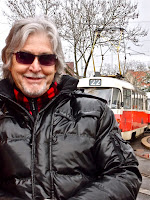That tells you something about the power of suggestion.
You see, my SO has this guidebook? Bible? It is her constant companion, even more than me I think... Nah, the old girl and I get along fine (most of the time); she just likes to know what's to be seen in new places we hang out in for a while. After all you can't cocoon all the time. And she has gazillions (exaggeration) of guidebooks.
 |
| inspiration for pirate flags and poison bottles? |
Anyway, to make a long story short, she's telling me about this place called Kutna Horror that has thousands of human bones for decoration in an ossuary (formerly a chapel). You have to understand one thing about her guidebook—it's in Japanese writing. Words of foreign origin are written in syllabic characters called katakana that try to phonetically depict the sounds of the original. What she was saying sounded to me like Kutna Horror and since it was a place full of human bones the name made sense to me.
Now, there is another place in the Prague suburbs called Bila Hora that means White Mountain. Enlightenment descended upon me and I made the connection between the two Horas. So I asked the SO: “Is this the same Hora as Kutna Hora?” Says she: “Well, yes, of course, what did you think?”
Never mind, we won't go into that.
We took a day trip (an hour by train from Prague) to Kutna Hora, a world heritage sight. Saw the gothic church of St. Barbara (begun, 1388; completed, 1558), patron saint of miners [the area had silver mines and a mint in town]. The church is interesting for its unusual roof lines which form concave pyramids [look a little like a three-ring circus tent). According to the promo literature, the church was entirely paid for by the local people without money from the Vatican. True believers indeed! We stopped for coffee and a salad in a little coffee shop near the church and then took the “scenic” route and walked three or four kilometers to the Sedlec Ossuary that contains the human bones of an estimated 40,000 to 70,000 people, 10,000 of which are used for the decorations.
And here I'll shut up and let the photos speak for themselves. See above link.

























































